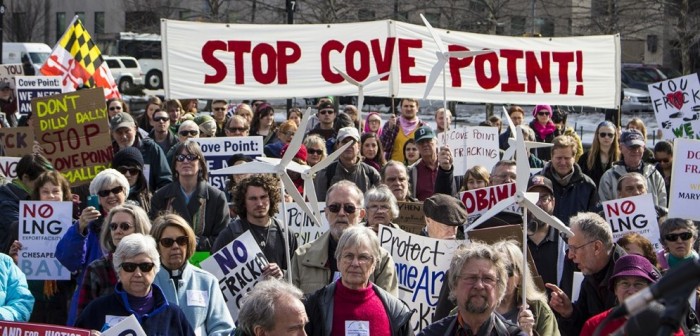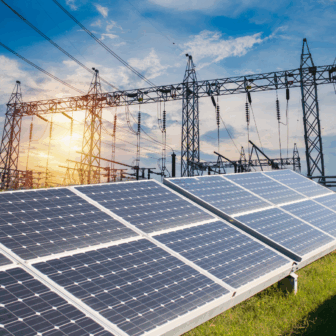Six months ago, few average Marylanders had heard of “Cove Point,” let alone understood the stakes for our communities and climate. Now, the fight to stop Dominion Resources’ proposed fracked gas export facility on the shores of the Chesapeake Bay in southern Maryland is making state and national headlines.
The issue broke onto the national scene in January when national climate leader and 350.org co-founder Bill McKibben coauthored A Big Fracking Lie in Politico Magazine with CCAN’s director Mike Tidwell. The opinion piece was a big (anti-)fracking success and, at more than 10,000 shares, it was one of the most shared Politico pieces in January. The piece explained in detail why Cove Point would be a disaster for our climate, spurring a new wave of fracking in the mid-Atlantic and causing climate polluting emissions equivalent to burning coal, and challenged President Obama to abandon his support for fracked gas exports.
Within Maryland’s borders, it’s the groundswell of grassroots action on Cove Point that has most recently driven headlines.
Last Thursday, February 20th, over 700 activists from around Maryland and mid-Atlantic states including West Virginia, New Jersey, New York, and the heavily fracked state of Pennsylvania gathered in Baltimore to say “Stop Cove Point.” The major showing of support for the movement generated newspaper, radio, and blog headlines in Baltimore and beyond.
DC Media Group:
DC Media Group goes in detail, quoting some of the speakers who inspired rallyers during the event. They also highlight a major theme of the rally, where “demonstrators repeatedly called on Governor Martin O’Malley and U.S. Senators Ben Cardin and Barbara Mikulski to compel federal regulators to conduct a comprehensive Environmental Impact Statement (EIS) for Cove Point.”
The Baltimore Sun:
The Baltimore Sun published this piece about the rally, focusing on the conflict between Dominion Resources, the company behind the proposed facility, and the environmental community. Paul Roberts, a Western Maryland winery owner, says “he’s concerned the state will be under far more pressure to allow the technique if natural gas interests can export from Cove Point.” That concern was echoed by other rally attendees, some of whom came from states already subject to fracking.
Live Leak:
LiveLeak got some great footage of the rally that shows the sheer size and spectacle of the event that close down city blocks in downtown Baltimore. They also paid close attention to the pipeline that led the march, saying it “drives home the point that this gas export facility and the infratstructure (sic.) to feed it would literally be MD’s Keystone XL in terms of climate consequences.”
This past week, Mike Tidwell also got the chance to address the Baltimore community in a discussion with Alan Krupnick, Senior Fellow and Director of Center for Energy Economics and Policy at Resource for our Future on the WYPR staple, Midday with Dan Rodricks. You can listen here to the full conversation about why fracked gas exports are a bad deal for Maryland and the United States.
The day following the rally, DeSmogBlog published a guest post from Joelle Novey, Director of Interfaith Power and Light, Katie Huffling, Program Director of Alliance of Nurses for Healthy Environments, and Mike Tidwell on why “We Need a Surgeon General’s Report for Fracked Gas Exports at Cove Point.” The piece brings a simple message to the Maryland Public Service Commission (PSC): “Don’t let Dominion addict Maryland to harmful energy. Stop the Cove Point gas export plant.” While the rally in Baltimore was timed with the start of key state level hearings at the Maryland Public Service Commission, the federal government must also sign off on Dominion’s plan – yet at this stage isn’t even planning to conduct the most rigorous and customary Environmental Impact Statement. The piece likens Cove Point and fracked gas exports to the national misconception in the 1950s that smoking cigarettes wasn’t harmful and was maybe even good for our health. Just as the surgeon general’s report on smoking showed Americans that we were poisoning ourselves, we need an Environmental Impact Statement on Cove Point to reveal the project’s true impacts to public health and the environment.
Since the rally, the national spotlight on the Cove Point project has increased. Caroline Selle published a piece on Huffington Post asking “Is The Cove Point Liquified Natural Gas Terminal The Next Keystone XL?” The piece gives a detailed explanation of how both projects would spell disaster for the climate, have serious safety questions as yet unanswered, and help the fossil fuel industry at the expense of other sectors of the economy. Bill McKibben makes the comparison clear, saying “[L]ike the Keystone XL pipeline for tar sands oil and the proposed export of dirty-burning coal through new terminals in the Pacific Northwest, this liquefied gas plan is bad in almost every way.”
The president is likely to make a decision on the Keystone XL Pipeline in the next few months. In the meantime, Cove Point is fast becoming a major galvanizing environmental issue for the East Coast. Its national environmental and economic implications make it a unifying issue for residents of Mid-Atlantic states facing the threat of expanded fracking. Just like the Keystone XL Pipeline, Cove Point is a plan to export our nation’s energy security, raising fuel prices at home and guaranteeing a long term dependence on dirty fossil fuels. Also like Keystone XL, Cove Point comes with a slew of attendant risks to human health and the environment. In the last two weeks, we’ve seen explosions of natural gas facilities destroy homes and even kill a worker in Pennsylvania. The compressor stations and pipelines needed to transport fracked gas over long distances also leak methane, one of the most powerful greenhouse gases, at rates higher than even the Environmental Protection Agency initially estimated, according to the Washington Post.
As the pressure in the media is rising, Dominion Resources has gone on the defensive, shelling out large amounts of money to pay for ads in major papers and even on the internet radio site, Pandora. While we’re keeping the pressure on Dominion, Marylanders are making their voices heard by submitting public comments to the Public Service Commission expressing their concerns about cove point. You can submit one here.






